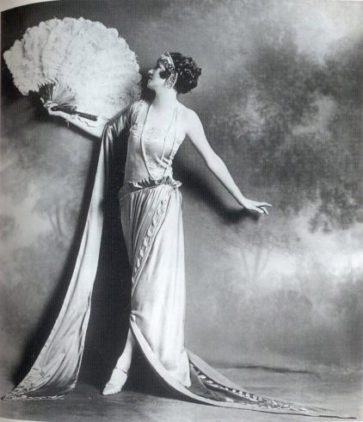In a fashion review article posted by the New York Times in January, an interesting question was posed: If Women Ruled the World, What Would They Wear? This simple inquiry also posed a unique rhetorical challenge, whether its author realized it or not. After all, who is it that actually dictates what women wear currently––men or women?––and what has patriarchy meant for mens and womens fashion respectively? As more and more female designers rise the ranks in the fashion industry, the dictation of trends and “what women would wear” has certainly shifted.
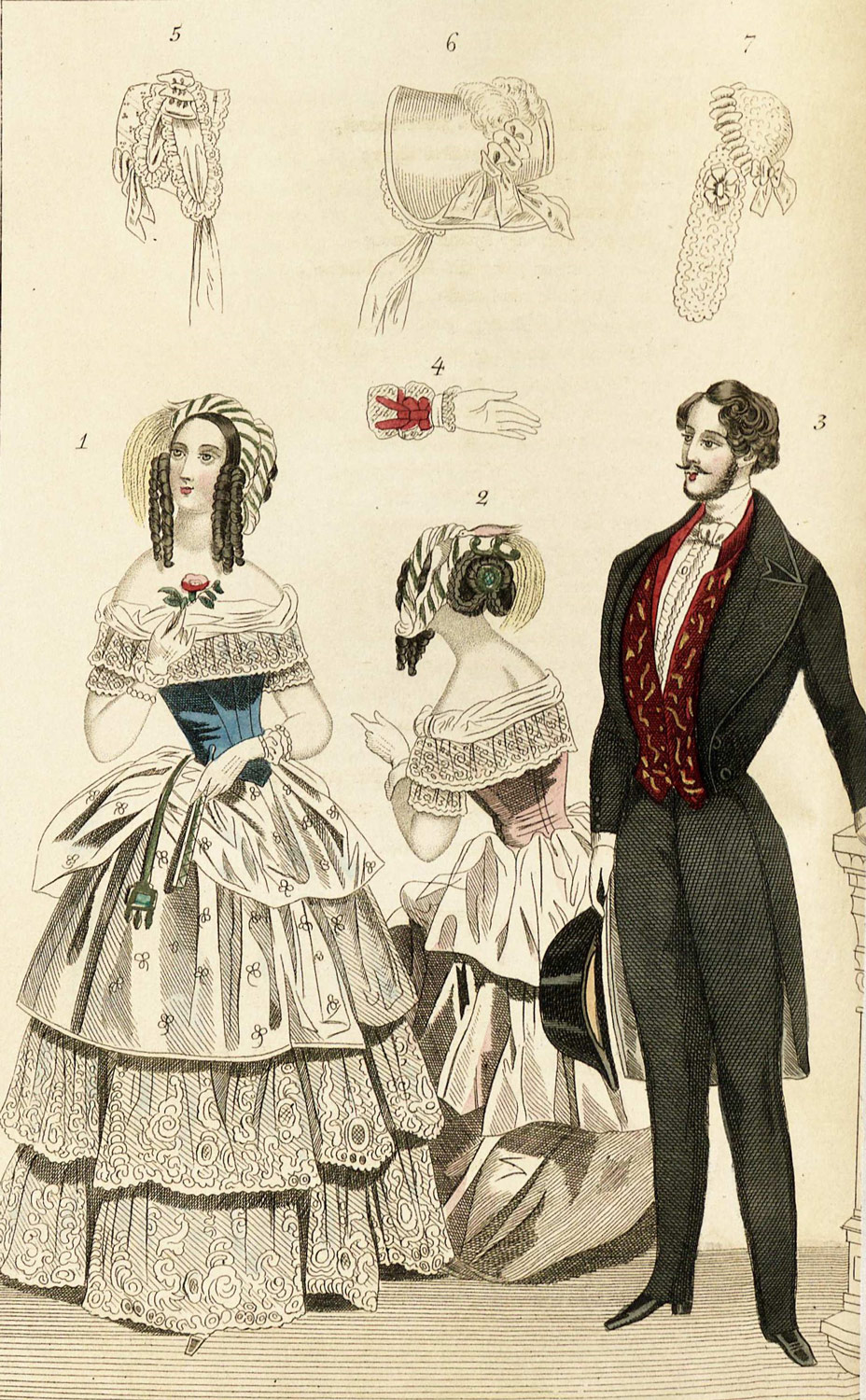
Traditional Victorian dress diagrams, a fashion era beginning with Queen Victoria’s reign in 1837 and ending in 1901 upon her death. It dictated extremely rigid regulations for dress, straight-laced and modest wear, with impractical but ostentatious dresses and suiting.
But up until extremely recent times, most designers of haute couture––as is the case in most professional spheres, from academics to politics to art––have been men. With the exception of a few like Madeleine Vionnet, Elsa Schiaparelli, and Gabrielle “Coco” Chanel, the paradox of the centuries stood that men have dictated the majority of what women wear.
This may come as no surprise: after all, as we explored in our past article “A Luxury Revolution: Fashion Past to Present and the Rise of Streetwear” , an English textile merchant by the name of Charles Frederick Worth was the first designer to sign and sell his garments, thus creating the first “couture house” in 1858: House of Worth. According to fashion historians like author E.P. Cutler, typically a woman would be the only acceptable party to outfit another woman: it was too indecent for a man to see, let alone touch a woman in undressing.
Fast forward to 2020 and a new fashion industry by women, for women is evitable. Heritage brands like Givenchy, Chanel, Céline, and Prada are all helmed by women. Experimental brands like Brothers Vellies and Stella McCartney have risen under female leadership; Comme des Garçons founder Rei Kawakubo is a force to be reckoned with. These and countless more contemporary female creative directors and designers have changed the way we dress.
Maria Grazia Chiuri
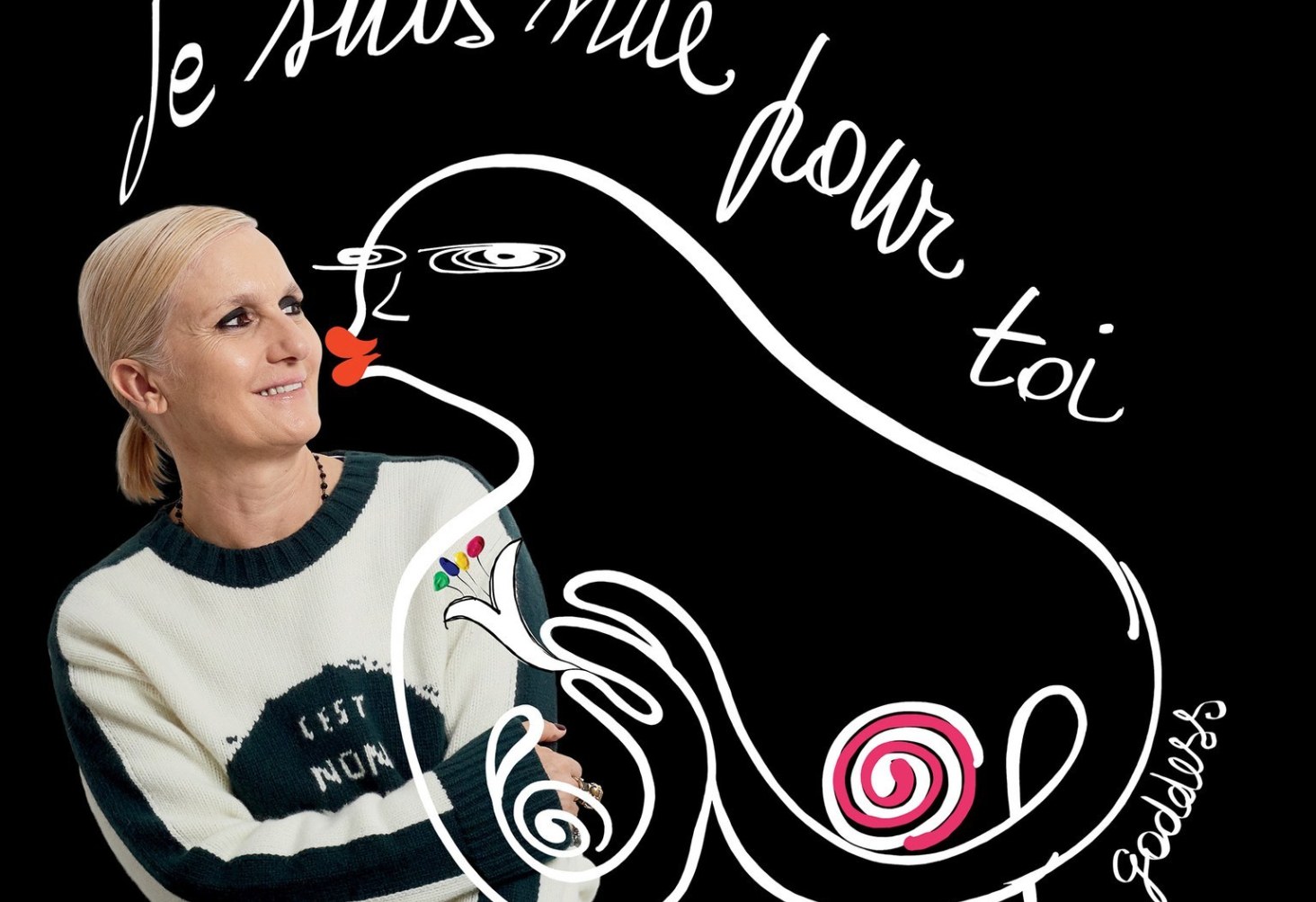
Christian Dior’s Creative Director Maria Grazia Chiuri, Italian fashion designer by trade who began her long career working her way into leadership roles at brands like Fendi and Valentino. Her work has been described as youthful, reactive, and aware; conscious of contemporary issues, which she seeks to address through fashion design.
In 2019 when the French secretary of equality Marlène Schiappa awarded the prestigious Legion d’Honneur to Dior’s artistic director Maria Grazia Chiuri, she was described through her favorite tarot card, “mort” or death, because as Schiappa stated, Chiuri “understands that it represents change.” Arguably, no figurehead in the contemporary fashion world embodies this sense of change better: when she was appointed creative director of Dior in July 2016, she was the first woman to ever own the role in the brand’s 70-year history. She previously spent 10 years as co-creative director at Valentino, partnered with Pierpaolo Piccioli, and prior to that was accessories designer for Fendi, part of the team that created the first It-bag “Baguette” shape. For her debut Spring/Summer 2017 collection, Chiuri famously stamped “We Should All Be Feminists” on a now infamous tee from that season, and has since championed close collaborations with female visionaries from Judy Chicago and Nigerian feminist author Chimamanda Ngozi Adichie. For her summer 2018 collection, Chiuri collaborated with French-American artist Niki de Saint Phalle, putting together a capsule of bold colors, pop illustrations, and sequinned symbols. Chiuri followed the next season with a top emblazoned with a quote from art historian Linda Nochlin’s seminal essay that peels back all the systemic reasons that women were excluded from the art establishment throughout history, “Why are there no great women artists?” Chuiri distributed the text at her show. In proper fashion, she continues to champion Dior’s explorations of feminism in a brand built of femininity, and how these go hand-in-hand.
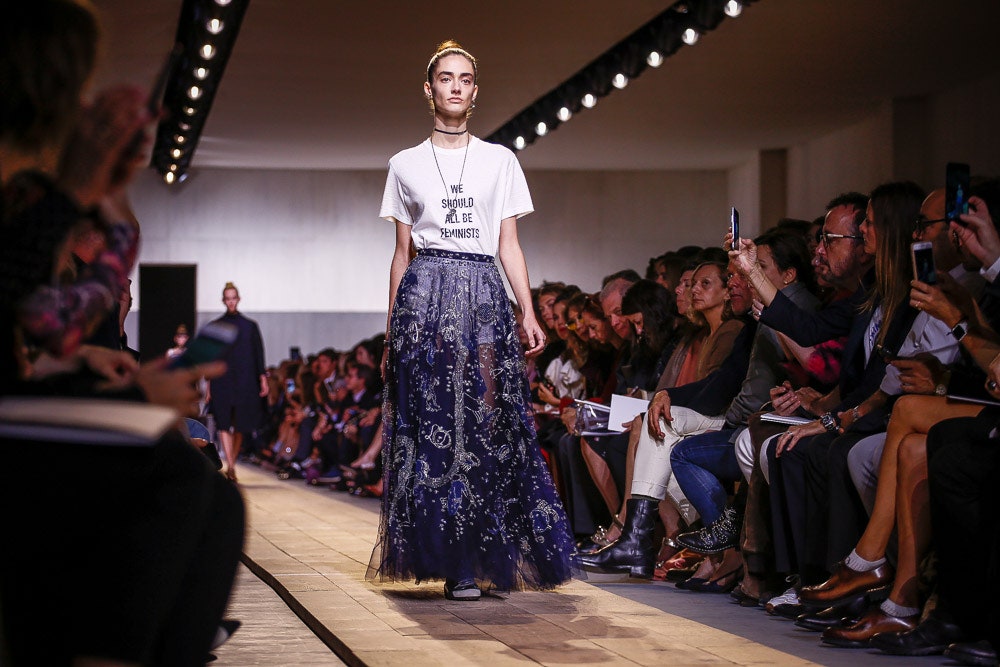
The infamous “We Should All Be Feminists” tee from Chiuri’s debut collection: especially in an industry where “feminism” can be a dirty word, this design was especially daring.
“Everyone told me Dior was a feminine brand,” Chiuri says. “OK. You want to talk about feminine now? What is feminine now?” A Maria Grazia Chiuri collection is now synonymous with clothing that women want to wear: a casting off Dior’s trademark history of diaphanous femininity was in order, in favor of modern, fresh, and empowered pieces. “When you look at a Maria Grazia collection for Dior,” says Anna Wintour, editor-in-chief of Vogue, “what you’re seeing are clothes that women really want to wear. I think that’s why it’s been so successful. At the same time, when she works at couture, it’s the best. The workmanship is extraordinary.” As exemplified through the brand’s radical updates, Chiuri’s vision for Dior is a house that speaks to the modern woman.
“Sometimes we have this message that the designer was a revolutionary. No, sorry. It was the woman that changed, and the designer understood and changed the line.” – Maria Grazia Chiuri
Rei Kawakubo
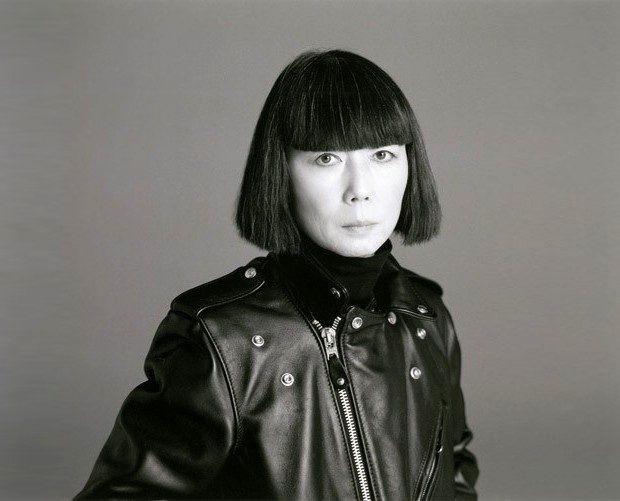
The enigmatic Rei Kawakubo, who began her career studying textile manufacture and working as a freelance stylist before founding her empire. She is famously averse to being photographed and explaining designs further than their titles. Recently, Kawakubo was the first living designer given a solo show at The Met’s Costume Institute since 1983, in the 2017 exhibition, ““Rei Kawakubo/Comme des Garçons: Art of the In-Between.”
As avant-garde as you would anticipate, fashion designer Rei Kawakubo denies that she is, in fact, a “designer,” or even “artist.” Occasionally fancies herself a businesswoman, but never consistently. Interviews with her are highly coveted and often challenging: once when asked an opening question by a reporter, Kawakubo supposedly drew a circle in black ink and walked out of the interview.
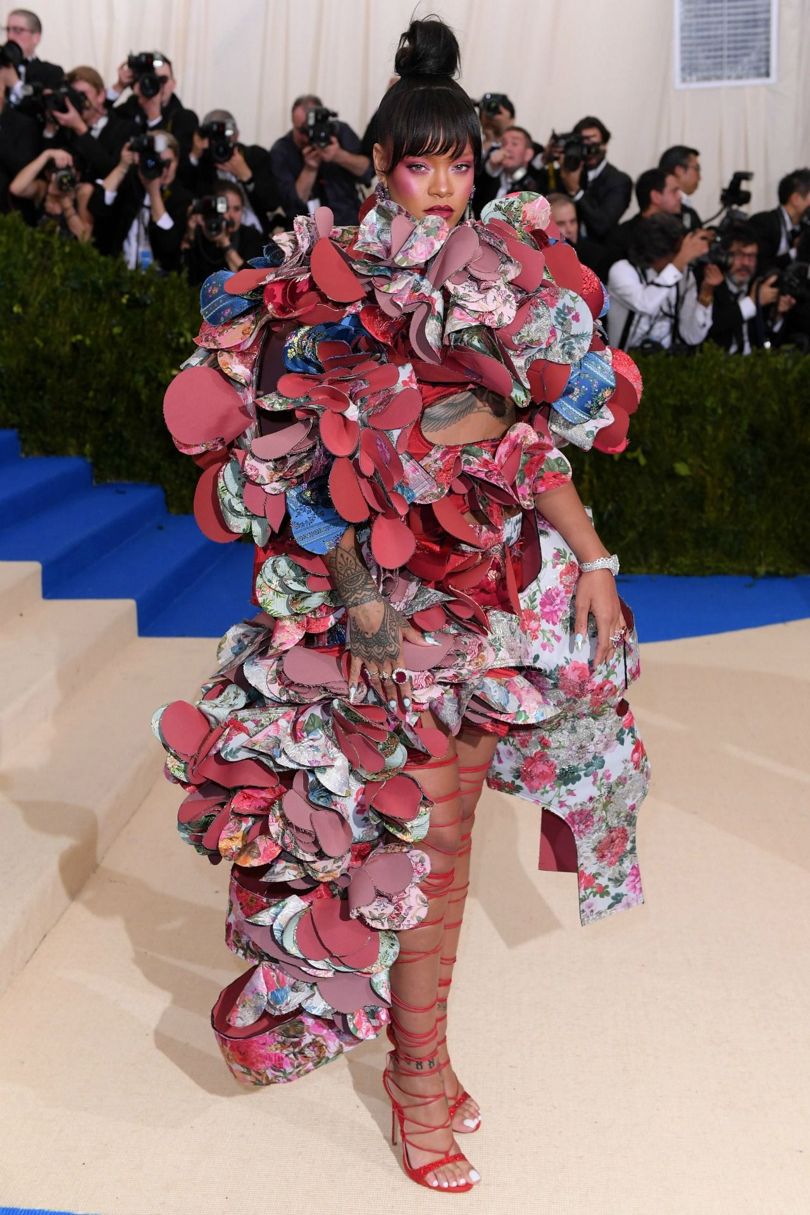
Singer Rihanna’s 2017 Met Gala Dress to celebrate the Costume Institute exhibition “Rei Kawakubo / Comme des Garçons: Art of the In-Between” from the Fall 2016 runway. Originally modeled by Anna Cleveland in Paris, the sculptural dress was inspired by 18th-century “punk” style and consisted of floral fabrics, layered and pulled apart like petals.
Born in Tokyo in 1942, Kawakubo began as a seamstress before launching her own designs as Comme des Garçons at age 27. After a mere 10 years, over 100 stores in Japan were selling her unique avant-garde garments. When Comme des Garçons finally made its Paris fashion week debut, Kawakubo lit the industry ablaze. Japanese aesthetic and cultural themes, with a dash of Parisian chic and punk anarchy made for an intoxicating cocktail, and the most compelling collection Paris had seen in years. Kawakubo went on to create several successful in-house brands, the largest being Play featuring a distinctive drawn-heart with eyes logo, which you’ve probably seen patched onto a tee-shirt or peeking out of the sole of a white pair of Converse sneakers. On a roll, in 2004 Kawakubo founded Dover Street Market in London, an arthouse department store featuring her designs as well as a few selected brands. Dover Street Market now has several locations including Tokyo, Beijing, New York, and Los Angeles. Comme des Garcons fittingly translates to “Like the Boys,” and indeed Kawakubo’s empire certainly continues to disrupt the creative director demographics.

The interior of Kawakubo’s Dover Street Market, New York; now one of seven locations globally. Kawakubo still hand-designs each major display of the department store.
“Fashion is something you attach to yourself, put on, and through that interaction the meaning of it is born. Without the wearing of it, it has no meaning, unlike a piece of art. It is fashion because people want to buy it now, because they want to wear it now, today. Fashion is only the right now.” – Rei Kawakubo
Miuccia Prada

Miuccia Prada’s leadership established very progressive ideals for the Prada brand, especially in her designs, which employed clean, simple lines and often muted, basic colors, paired with luxurious fabrics and fine tailoring. These understated trademarks imparted a refined elegance, standing in strong opposition to the overt “sex appeal” of many of the brand’s competitors, like Tom Ford and Gucci at the time.
Miuccia Prada, the head fashion designer and co-creative director of Prada, is constantly surrounded by buzz and high praise. “She is a curious capitalist philosopher with a brilliant instinct for modern desire,” New York Times Style Magazine writer Andrew O’Hagan wrote of her. Her mere name, and the family history of that name, is sure to conjure associations.
Miuccia’s grandfather, Mario Prada, made leather goods in a small shop in Milan. The shop passed through the generations until it landed by an eager Miuccia, known to the family as Miu Miu. Her design career took off with her 1984 creation of Prada’s nylon rucksack: designed from parachute material, the minimalist black bag built her a cult following. Partnered with her husband Partizio Bertelli, she turned the family luggage business into a fashion powerhouse, with sales of over $5 billion.
But the most pivotal point in Miuccia’s career is her attribution to the style belle laide, or “ugly chic:” a revolutionary fashion development that investigated ugliness versus conventional beauty. In her now-legendary Spring/Summer 1996 collection titled “Banal Eccentricity,” Miuccia set trends that upended stuffy ideas of elegance and sexiness championed by her contemporaries, and with it, centuries-old standards of female beauty. Her shows sent her contemporaries like Tom Ford and Marc Jacobs absolutely reeling. How does she do it? How could Miuccia turn retro-geeky cuts, chartreuse, ochres, and smoggy shades of brown––once overlooked and neglected––into the most sought-after styles of the 90s? Miuccia’s pioneering Prada collections do more than self-gratify: they prodd and question the consumer, coaxing typically sheepish fashion followers into their own radical self-invention.
For all of her bravery, Miuccia oversees a massive empire of Prada, Miu Miu, and English shoe brand Church’s. Interestingly enough, she also holds a Ph.D. from Milan University in political science, and worries frequently that as a fashion designer keeps her from adequately addressing social issues. But an iconoclast at heart, Miuccia finds a way to make great waves in her sphere––by stoking a healthy appetite for change in the realms of art, culture, fashion and beyond.
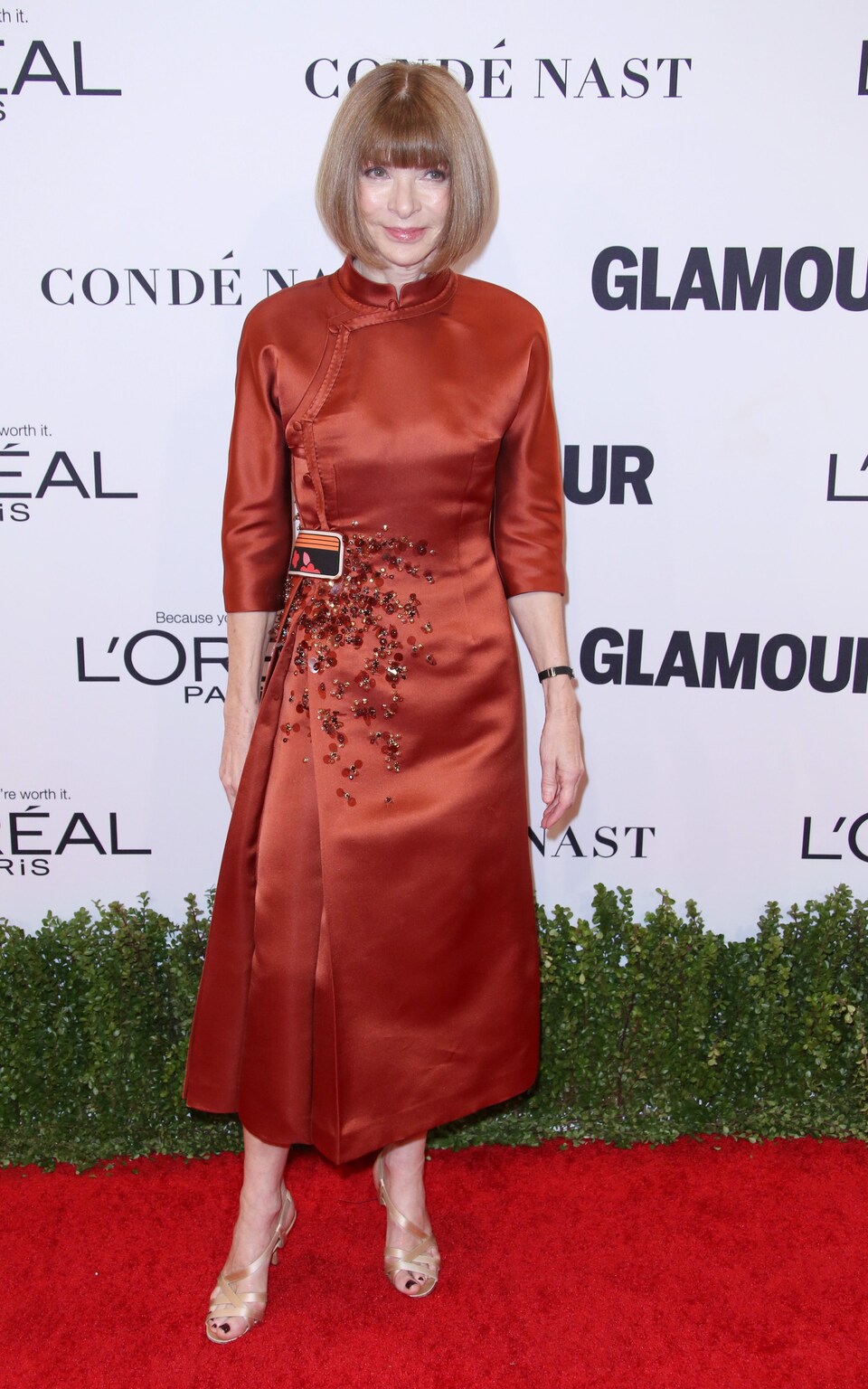
Anna Wintour, British-American journalist and editor who has been editor-in-chief of Vogue since 1988 and artistic director for Condé Nast, Vogue’s publisher, since 2013. The 2006 film “The Devil Wears Prada” is loosely based on Vogue, and the experience of its main character as personal assistant to editor Miranda Priestley, allegedly based on Wintour.
“Ugly is attractive, ugly is exciting. Maybe because it is newer,” she said. “The investigation of ugliness is, to me, more interesting than the bourgeois idea of beauty. And why? Because ugly is human. It touches the bad and the dirty side of people. You know, this might have been a scandal in fashion but in other fields of art it is common: in painting and in movies, it was so common to see ugliness. But, yes, it was not used in fashion and I was very much criticized for inventing the trashy and the ugly.” – Miuccia Prada
Virginie Viard
The celebrated Chanel creative director Karl Lagerfeld is an extremely tough act to follow, whose mere stern silhouette of slicked white hair and black shades is immediately recognizable worldwide. But when his right-hand woman Virginie Viard stepped into his very-large shoes in the role of the fashion house’s artistic director, she became the first woman with the title in decades, since Gabrielle Chanel herself.
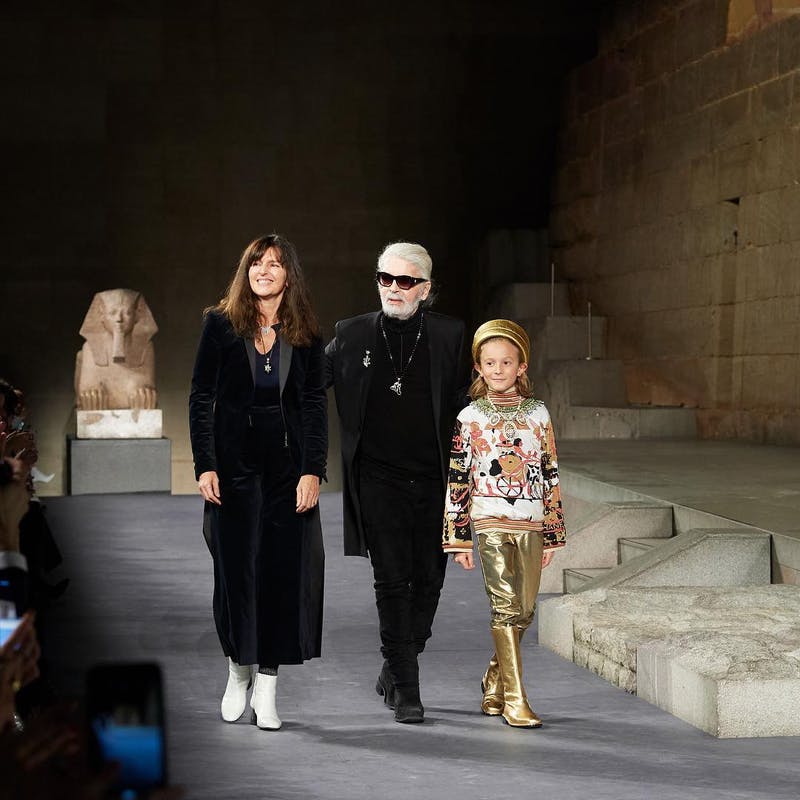
Virginie Viard and the late Karl Lagerfeld, whose position at Chanel Viard would eventually take over.
Though Viard had been with Chanel for 30 years prior to her appointment, she kept largely out of the spotlight, unlike the animated Lagerfeld, but steadily she began taking bows with him at the end of runway shows. They worked side by side, going between work with Chanel and Chloé: Lagerfeld once declared, “She is my right arm and my left arm.”
In 1987, Viard was born in Lyon, France, hailing from a family of silk manufacturers. She studied theater and costume design, starting at Chanel in 1987 as an intern on the recommendation of the chamberlain to Prince Rainier of Monaco. Now taking over Lagerfeld’s role, Viard oversees all of Chanel’s collections as artistic director of fashion collections, including haute couture, “RTW,” and accessories. Viard’s Chanel is a $10 billion-dollar brand that has maintained one of the most renowned fashion legacies in history, but with collections that have democratized womens fashion. Her direction has liberated the brand, making comfortable, practical, unpretentious and unforced glamor out of jodhpur pants and roomy Edwardian coats. “Freedom!” shouted Virginie Viard during a fitting in Chanel’s rue Cambon atelier on the eve of her breezy Fall 2020 show. Finally freedom to Chanel, indeed.
Guo Pei
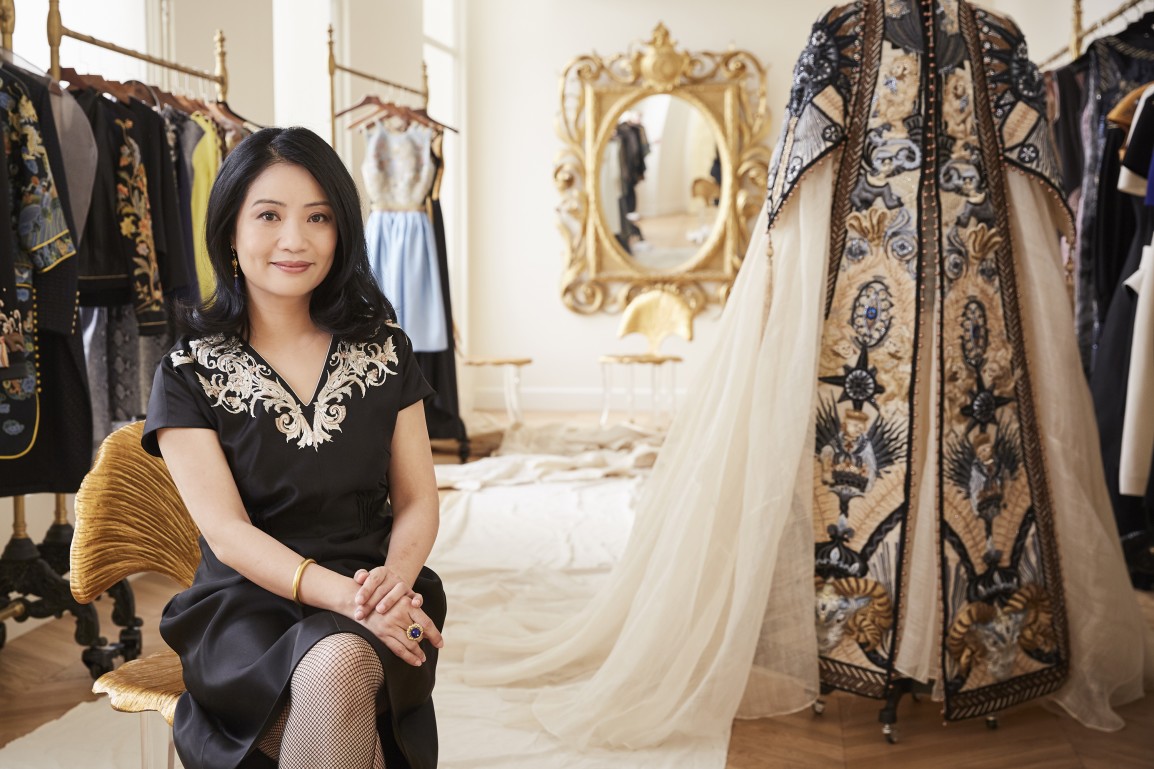
Guo Pei in her Paris atelier, photo by Chris Floyd, showcasing the exquisite and pain-staking embroidery that is signature to her aesthetic.
At the Met 2015 Gala, singer Rihanna stepped onto the red carpet in an elaborately embroidered, trailing fur-trimmed creation designed by master couturier Guo Pei in a glorious yellow, a color traditionally reserved for the Chinese emperor. It was a truly unforgettable moment for all who were present, and established Pei’s work in the western fashion world’s larger consciousness.
China’s most famous couture designer, Guo Pei has since become a global icon, representing China as the first Chinese guest member of the Chamber Syndicale de la Haute Couture (and second Asian guest member overall) in 2016. Pei grew up in a Chinese Communist party, which meant early discouragement of her artistic inclinations. However, she still managed to graduate with a degree in fashion design, and went on to work at one of China’s first privately owned fashion brands, Tianma.
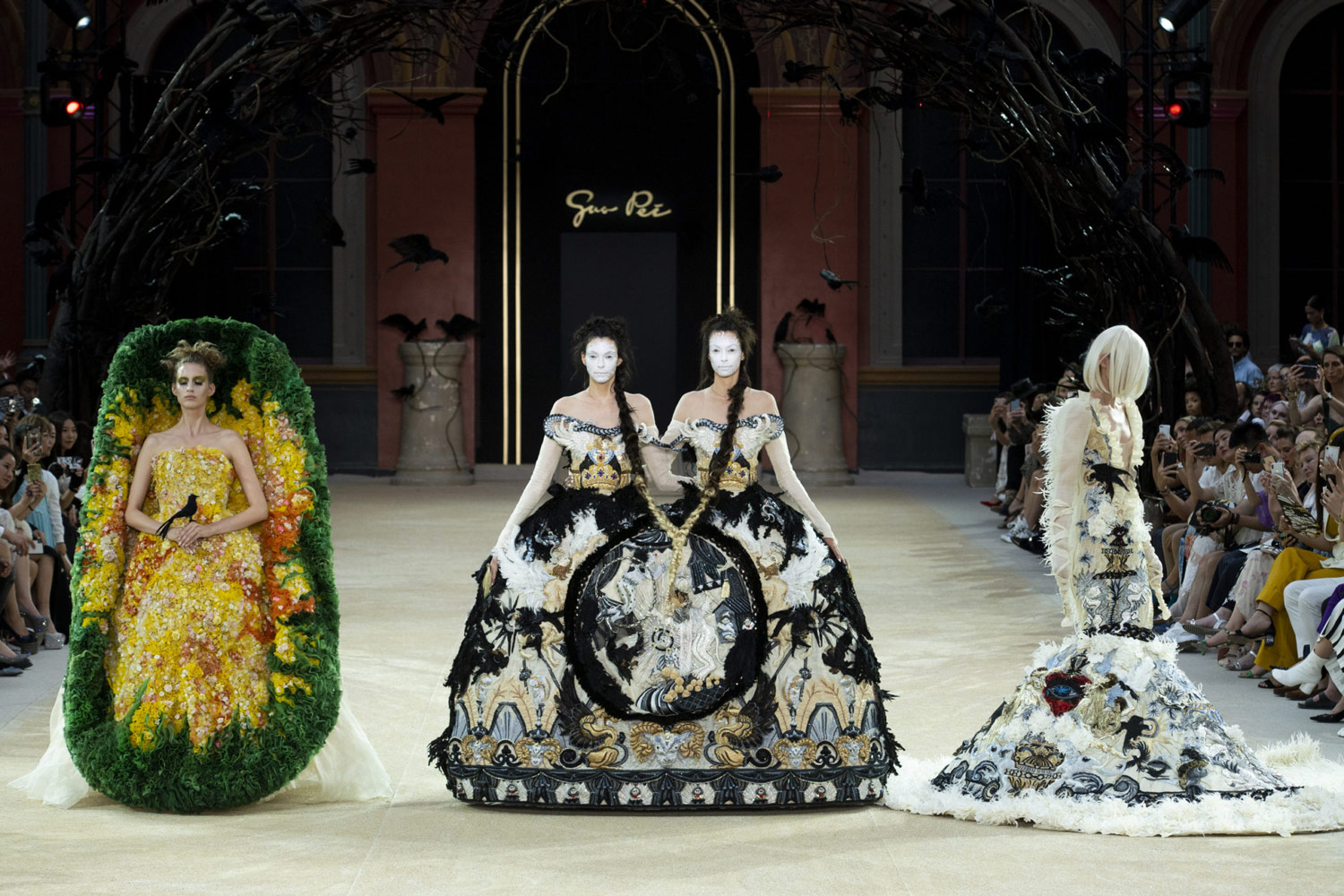
Guo Pei presents her Autumn/Winter 2019/20 Haute Couture collection at the Beaux-Arts de Paris; a collection based on folklore, and the idea of an “alternate universe” at the edge of light and dark.
Pei went on to design distinctive clothing for the 2008 Olympics for both athletes and Song Zuying in her closing ceremony show, as well as clothing all of the biggest Chinese celebrities. In 2018, she made her debut at Paris Couture Week, and was named one of Time magazine’s 100 Most Influential People. Since her inclusion in couture, she’s had numerous showings at Paris Fashion Week and at La Concierge. Her most recent Haute Couture Spring/Summer Show featured strongly the French idea of l’heure bleue, a dark blue hinting at dusk. Combined with intricate embroideries, this theme was included in every piece, and according to Pei represented life force and roots saying, “Roots are the source of life and vitality…Without roots, there’s not life. This world is a very mysterious place, but it’s linked intimately with our lives. That’s why the tree is onstage, and you’ll see a lot of flowers.” Exploring roots and heritage, Pei finds inspiration in folklore and legends, and their ties to heritage, such as her 2012 collection “Legend of the Dragon.”
“Fashion and extravagance are important to art. Even if you’re designing a house or a piece of furniture, there is a pursuit of art involved. Art goes beyond reality. Some people might find certain artworks OTT, oversized or exaggerated. But if you try to feel it with your heart instead, you’d understand the meaning of its existence. Art inspires people to think more.” – Guo Pei
Iris Van Herpen
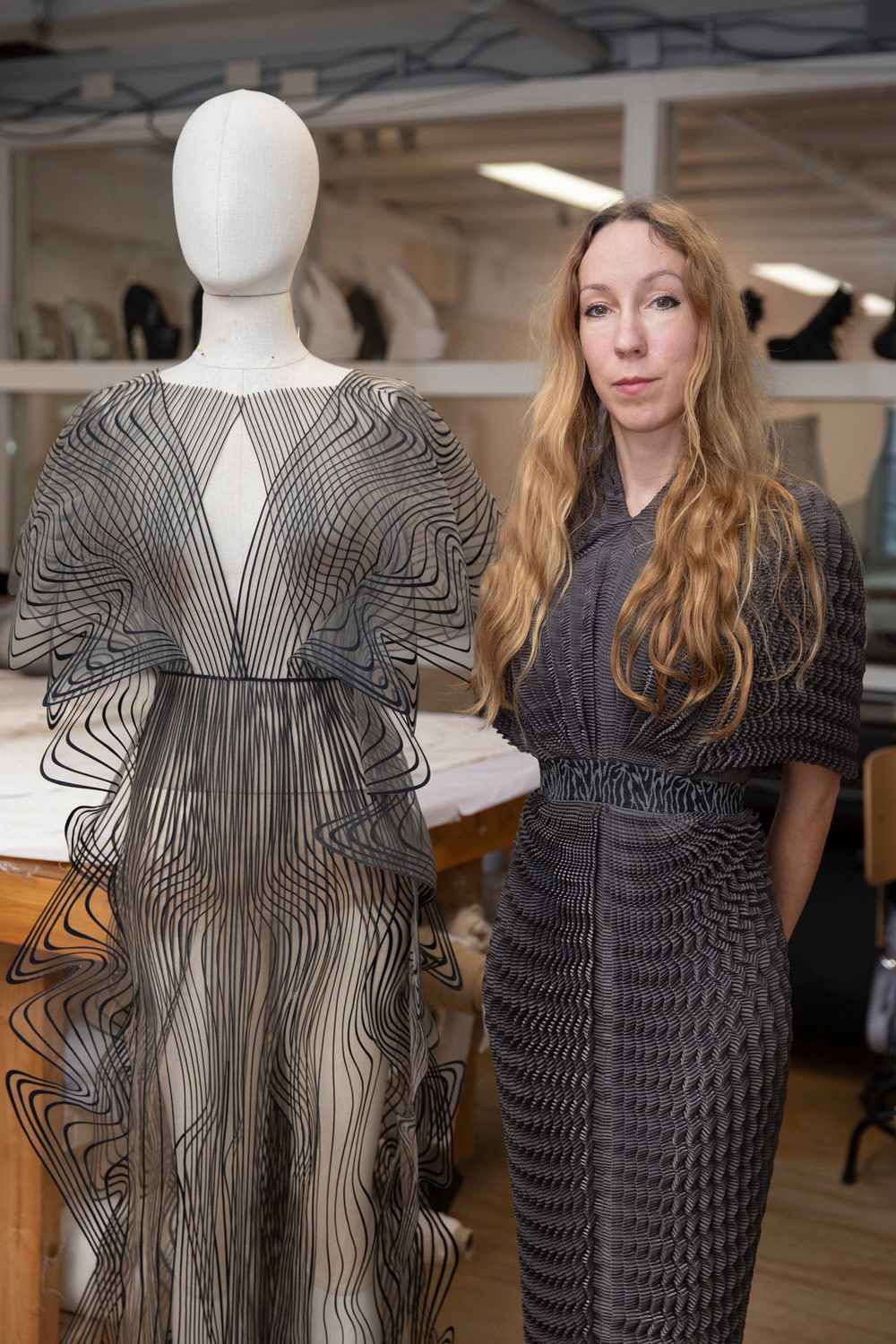
Iris van Herpen, a 36-year-old Dutch designer who founded her own company in 2007, next to one of her creations.
Art and fashion often dictate the need for a sophisticated consciousness of the past. And yet, one Dutch designer seems to find a need only for the present and future for her high-tech couture. Simply take the titles of numerous Dezeen articles and you get a sense for Van Herpen’s constant innovating, at the cross-section of fashion and technology: “Iris van Herpen uses 3D printing and magnets to form Spring Summer 2015 fashion collection,” “Iris van Herpen explores human-animal hybrids in Shift Souls couture collection,” or “Iris van Herpen uses robots to print and weave a dress over Game of Thrones actress.” Here is a designer who makes her own rules.

Iris van Herpen’s Hypnosis Collection, exploring the hypnotic visualization of nature’s tapestry.
Van Herpen’s concepts are like nothing the couture world has ever seen, often drawing from natural science, creating strangely mesmerizing and delicately gorgeous garments. Her couture is immediately recognizable for their fantastical and architectural aesthetic, simply free from the expectations and constraints of the past. Rather, Van Herpen is on a constant bend for new forms and techniques, from 3-D printing, to laser cutting, to heat bonding. She searches for completely novel materials, from silicon to magnets to foam. while they may not lend themselves to women’s closets, they certainly do to art institutions. In 2012, the Metropolitan Museum made its first acquisition of her work—a minidress that resembles a stylized skeleton and was 3-D-printed with a white synthetic polymer. The museum has since acquired five more of her designs, including the “moon dress” of 2013-14: a doughnut-shaped garment whose iridescent black resin surface is textured and cratered. “Growth processes, or nature in general, are the basis of my work,” Van Herpen stated in a New Yorker interview.

A piece from Iris van Herpen’s Shift Souls collection, inspired by early examples of celestial cartography and its representations of mythological and astrological chimera.
“In all my work I try to make clear that fashion is an artistic expression, showing and wearing art, and not just a functional and devoid of content or commercial tool. With my work I intend to show that fashion can certainly have an added value to the world, that it can be timeless and that its consumption can be less important than its beginning. Wearing clothing creates an exciting and imperative form of self-expression.” – Iris Van Herpen
Interestingly enough, some common threads seem to run through the garments and collections of these creative directors: an interviewer asked a Dior staffer about what has changed since Maria Grazia Chiuri took over creative direction of the design house. “The shoes,” she stated plainly, “are far more comfortable.” This anecdote speaks volumes to the changes that female creative directors have injected into the industry: garments that are relevant to the times, in greater consideration of the women wearing them, conceptually-elevated and physically unconstrained. We can’t wait to see the journey that these women take us on in their more comfortable shoes.




